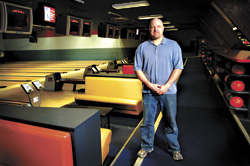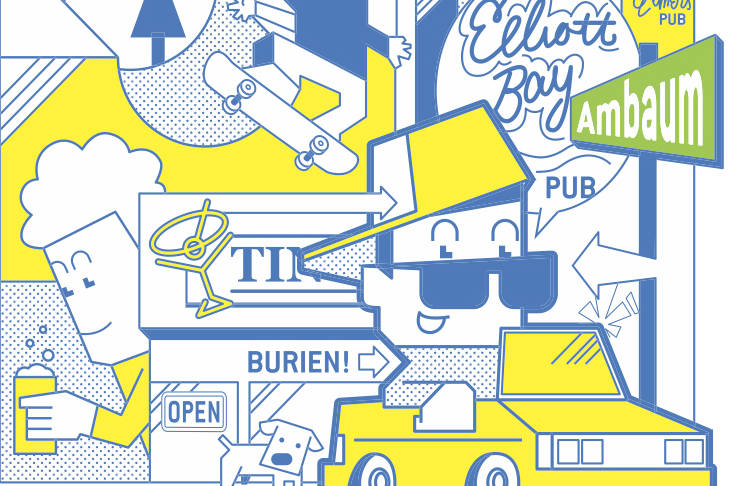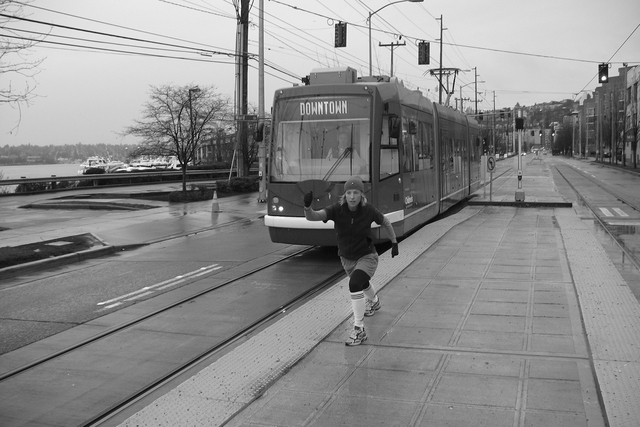For decades, West Seattleites have been able to count on two things: low-slung, blast-from-the-past architecture and an abundance of free parking. (There are no meters on the peninsula, even in bustling corridors like the Alaska Junction.) But now, as urban sprawl’s unstoppable march has dented the dam of Seattle’s last backwater frontier, the massive neighborhood’s surefire ideals are being threatened, with Exhibit A being the proposed Fauntleroy Place development.
With Whole Foods and Hancock Fabrics, the latter of which currently sits on the parcel in question, signed on as anchor tenants, Blue Star Development’s five-story structure at the corner of 39th and Fauntleroy includes plans for underground parking and 170 apartments, many of which would feature views of downtown Seattle and the Cascade Mountains. Blue Star has already cleared most of the requisite regulatory hurdles and expects to break ground sometime this spring. Meanwhile, a couple of blocks west, construction has commenced on a similar megaproject involving QFC.
“I’ve been a resident [of West Seattle] since 1988,” says John Lockie. “And while you can gentrify the area to a certain extent, what we’re seeing here is an age of greed.”
Lockie is a regular at one of Seattle’s last remaining bowling centers, West Seattle Bowl, which sits on a parcel adjacent to the proposed Whole Foods development. Before Blue Star purchased the property from Hancock in a lease-back deal in 2007 (plans for Fauntleroy Place began well before the sale closed), the bowling center’s customers were allowed to park in an adjacent lot, then owned by Hancock, free of charge. Yet one night, this past August, Lockie was startled to find a ticket from Diamond Parking tucked beneath his windshield wiper.
“I’d been bowling there for seven or eight years, and I didn’t see any Diamond Parking signs,” recalls Lockie. “They must have put them in in the middle of the night.”
Brian Mueller had a similar experience, which compelled him to start parking in front of the homes that line 40th Avenue Southwest. “One of the residents left a note on my windshield telling me not to park in front of their house,” says Mueller, who’s been a league bowler at West Seattle for the past decade. “It’s only $2,” he adds, referring to the new fee to park in the formerly free lot after 6 p.m. (it’s still free during off-peak daylight hours), “but it’s kind of the principle of the matter. If this is how the developer is going to treat the bowlers, once Whole Foods is there, I’m not going to patronize it.”
After the development is completed, the lot in question will no longer exist, giving way to the footprint of the new building, made possible when Blue Star secured an alley vacation from the city in 2006. To seal this deal, which gives Blue Star stewardship of a once-public right of way, the developer transferred control of a driveway on the north side of the current Hancock Fabrics building to the city in lieu of cash. It also convinced West Seattle Bowl’s landlord, the Hsiao family, to sign off on the vacation. “They were very gracious,” says Blue Star project manager Easton Craft, “and felt the project would be good for the neighborhood.”
Maybe so, but you wouldn’t know it from talking to the Hsiaos’ tenants, West Seattle Bowl owners Andy Carl and Mike Gubsch. They claim to have been cut out of a critical loop by both their landlord and Blue Star, and their struggles are emblematic of the lethal local saga of America’s most popular indoor sport.
Carl and Gubsch have known each other since they were 11. Both grew up in Edmonds, the home of Robin Hood Lanes—where they each worked and which Gubsch still helps manage. When the pair took over West Seattle Bowl in 1996, “Sunset [Bowl, in Ballard] and Leilani [Lanes, in Greenwood] were kicking our ass,” says Carl. But three years ago, they completed an extensive remodel, and, says Carl, “business has steadily increased since”—a bottom line that only stands to benefit when Sunset is converted to condos in April. The shuttering of Leilani in 2006 for similar purposes didn’t hurt either.
“Leilani was the tipping point,” says Carl. “And everybody’s just been going crazy since.”
West Seattle Bowl and Imperial Lanes in the Rainier Valley are the last two traditional bowling centers still operating within the city limits. (Capitol Hill’s Garage is part of a new, urbanized hipster format that eschews league play in favor of a clubby, adults-only atmosphere.) Of the two, West Seattle remains on the most stable footing, with a lease that extends through 2017. As for Imperial, last year there were rumors that the center was going to be transformed into a strip mall until its owner, AMF, eventually signed a new short-term lease.
“At the time those lanes were originally built, they were more on the outskirts of town,” says Russell Jones, vice president of operations for Lucky Strike Lanes, which just opened a 16-lane Bellevue facility in the Garage style. “Now urban sprawl has come out to those areas, and for the amount of money people are willing to pay to get that sort of real estate, there are really not many people willing to invest that kind of money in a big old bowling alley. A lot of those [centers] were family-owned, and either the family retires or the kids aren’t interested. This is kind of their way out into retirement.”
Carl says he and Gubsch have offered to buy the land their center sits on from the Hsiaos, to no avail. Still, Carl remains undaunted, insisting, “We’re always going to find a way to stick it out, especially with Sunset closing.”
But the Hsiaos, by not consulting their tenants before signing off on Blue Star’s alley vacation in July 2006, put Carl and Gubsch in a tough spot. “We confronted our landlord and said, ‘Look, you kind of threw our ability to negotiate parking and property rights out the window,'” says Carl, who’d been engaged in what he thought were good-faith negotiations with Blue Star since January 2005. (The Hsiaos declined to comment for this story.)
Shortly before the developer gained control of the alley, communication between the two parties came to a virtual halt. Blue Star spokesperson Eric Radovich attributes this breakdown to Carl’s decision to retain the services of a land-use expert who, in Radovich’s words, “just assumed everything we said was a lie. So we moved discussions to talking to the owner of the property.”
Still, this past summer, Radovich swung by the center to speak with Carl about the parking situation. Shortly thereafter, unbeknownst to Carl, Blue Star brought in Diamond Parking to manage the lot. In an Aug. 2 e-mail to Carl, Radovich explained that this maneuver was prompted by liability concerns, a rationalization which, in the eyes of land-use attorney Mike Spence of Harrison, Benis & Spence, appears to pass muster.
“There’s all this disclaimer language on the back of the [parking ticket] stub that says you’re not going to have any legal claim against them should somebody break into your car,” says Spence, who adds that the unmanaged, free-lot arrangement could have potentially opened Blue Star up to liability, given the absence of such a disclaimer.
As it stands, Carl is looking into purchasing additional insurance to protect his business against potential damages incurred during construction, an act he claims was precipitated by Blue Star’s unwillingness to talk specifics.
“They weren’t willing to get any dialogue about construction methods, whether we can hold them accountable for damage during construction, and the long-term relationship between us and Whole Foods and parking,” Carl laments. “There can’t just be smoke and mirrors.”








